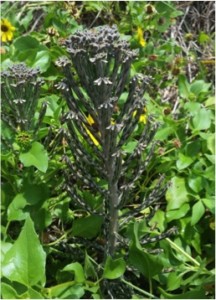Today marks the end of Florida Invasive Species Week and the beginning of National Invasive Species Awareness Week.
According to the US Department of Agriculture, an invasive plant is defined as, “A plant that is both non-native and able to establish on many sites, grow quickly, and spread to the point of disrupting plant communities or ecosystems.” These invasive plants can increase the severity of wildfires, impede water flow, make areas inaccessible to wildlife and can harm crops.
 One plant GTM Research Reserve is monitoring as a potential invasive plant is the Kalanchoe plant, also known as the “mother of millions” or “chandelier plant.” This not-so-friendly succulent is a self-fertilizing plant that produces more than 16,000 seeds per fruit and forms dense blankets across dunes.
One plant GTM Research Reserve is monitoring as a potential invasive plant is the Kalanchoe plant, also known as the “mother of millions” or “chandelier plant.” This not-so-friendly succulent is a self-fertilizing plant that produces more than 16,000 seeds per fruit and forms dense blankets across dunes.
Historically the plant was given as a housewarming gift due to its beautiful pink flowers and its ability to grow no matter what. Unfortunately that very characteristic has led to the plant outcompeting native vegetation. The plant’s shallow roots are harmful to dune systems since they do not hold the sand in place like native sea oats do.
First Coast Invasive Working Group (FCWIG) has partnered with Florida Native Area Inventory (FNAI) and numerous agencies to survey the Kalanchoe spp. population within Nassau, Duval, St. Johns, Clay, and Baker counties. Species of the Kalanchoe plant cause for concern are the Kalanchoe x houghtonii and Kalanchoe diagremontianum.
For more information email [email protected] or [email protected], or call (904) 823-4500.


